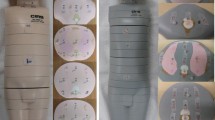Abstract
Pediatric dosimetry requires extra attention as young children are three times more sensitive to radiation than the average population. Soft tissues of patients absorb low-energy photons without affecting useful diagnostic information. X-ray filters can decrease the exposure dose of radiation by removing low-energy photons from the X-ray beam. Several studies have dealt with the advantages of a conventional filter, copper (Cu), in pediatric digital X-ray radiography. Only a few studies, however, have examined the use of molybdenum (Mo) filters and their impact on the radiation dose and image quality in pediatric digital X-ray imaging. In this study, we investigated the impact of a Mo filter on the image quality and the entrance surface exposure (ESE) in pediatric X-ray imaging and assessed the potential of additional dose reduction compared to a conventional Cu filter. The performance of the Mo filter was investigated and compared with that of Cu filter. Two types of phantoms were used: a customized quantitative phantom (Phantom A) for quantitative comparison and a computational anthropomorphic extended cardiac-torso (XCAT) phantom for qualitative comparison. A clinical radiography system was modeled, and the clinical setting for pediatric chest X-ray imaging was considered. Geant4 simulations using Monte Carlo toolkits were performed to obtain the images for pediatric chest X-ray examinations. Quantitative and qualitative comparisons using the quantitative phantom (Phantom A) and the XCAT phantom, respectively, were performed for both filters. From the customized quantitative phantom study, the ESE for the Mo filter was compared with that for the Cu filter when contrast-to-noise ratio (CNR) was equal. In addition, to validate our Monte Carlo model, we compared simulated and experimentally acquired images. From the results, the ESE for the Cu filter was 22.62 μGy while the ESE for the Mo filter was 18.18 μGy for 5-mm soft tissue. The use of a Mo filter results in a reduction in the dose by 19.60%. From the XCAT phantom study, the image for the Mo filter was superior to that for Cu filter in terms of noise and recognition of blood vessels. The performance characteristics of the Mo filter were evaluated in terms of image quality and radiation dose by comparing those characteristics to the ones for a conventional Cu filter. Our results demonstrated that the use of the Mo filter can significantly reduce the radiation dose. Based on this result, Mo filters are recommended for use in pediatric digital X-ray imaging.
Similar content being viewed by others
References
ICRP, Managing Patient Dose in Digital Radiology, ICRP Publication 93, Ann. ICRP 34, 1 (2004).
ICRP, 1990 Recommendations of the International Commission on Radiological Protection, ICRP Publication 60, Ann. ICRP 21, 1 (1991).
J. A. Seibert, Pediatr. Radiol. 34, S183 (2004).
D. J. Brenner, C. D. Elliston, E. J. Hall and W. E. Berdon, Am. J. Roentgenol. 176, 289 (2001).
M. Uffmann and C. S. Prokop, Eur. J. Radiol. 72, 202 (2009).
R. Schaetzing, Pediatr. Radiol. 34, S207 (2004).
J. Stecke, A. D. Cruz, S. M. Almeida and F. N. Boscolo, Dentomaxillofac. Radiol. 41, 361 (2012).
P. Brosi et al., Radiol. Phys. Technol. 4, 148 (2011).
European guidelines on quality criteria for diagnostic radiographic images. Luxembourg, European Commission (1996).
S. Agostinelli et al., Nucl. Instrum. Methods Phys. Res. A 506, 250 (2003).
J. Allison et al., IEEE Trans. Nucl. Sci. 53, 398 (2006).
J-F. Carrier, L. Archambault, L. Beautieum and R. Roy, Med. Phys. 31, 484 (2004).
A. Lechner, M. G. Pia and M. Sudhakar, IEEE Trans. Nucl. Sci. 56, 398 (2009).
G. Poludniowski et al., Phys. Biol. Med. 54, N433 (2009).
W. P. Segars and B. M. W. Tsui, Proc. IEEE 97, 1954 (2009).
ICRP, Basic Anatomical and Physiological Data for Use in Radiological Protection Reference Values. ICRP Publication 89. Ann. ICRP 32, 3 (2002).
Author information
Authors and Affiliations
Corresponding author
Rights and permissions
About this article
Cite this article
Park, SJ., Kim, J., Han, J.C. et al. Evaluation of the Use of a Molybdenum Filter for Dose Reduction in Pediatric Digital X-ray Imaging. J. Korean Phys. Soc. 77, 1253–1259 (2020). https://doi.org/10.3938/jkps.77.1253
Received:
Revised:
Accepted:
Published:
Issue Date:
DOI: https://doi.org/10.3938/jkps.77.1253




